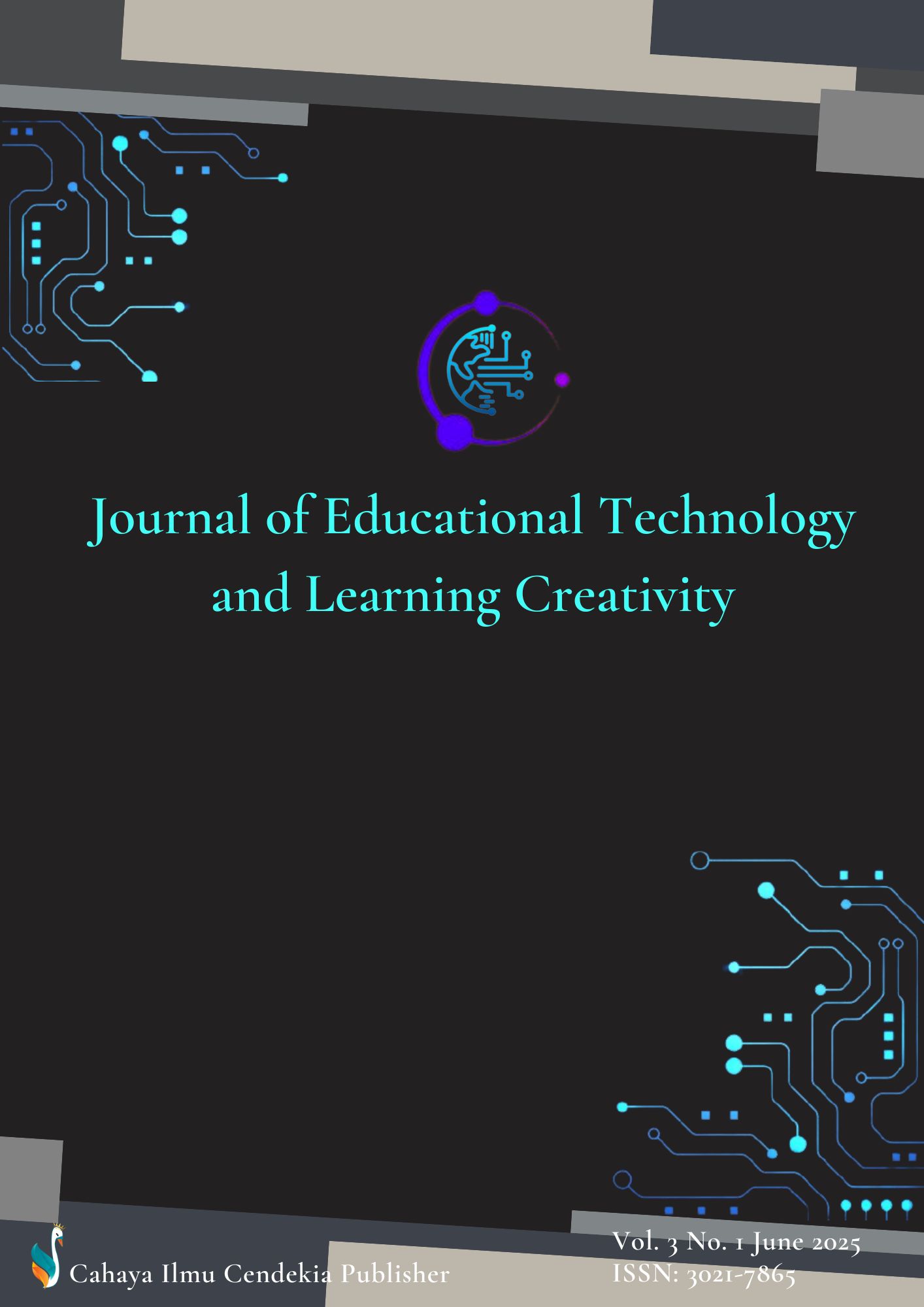The Adoption of Agriculture Technology in Small-Scale Farming in The Adumasa Community in Ghana
Abstract
Purpose of the study: This study aims to identify socio-economic and institutional factors influencing the adoption of agricultural technologies by small-scale farmers in Adumasa. The study explores the types of technologies used and the factors that determine their adoption decisions, considering their benefits and drawbacks.
Methodology: This study used a qualitative approach with a sample of 15 farmers from the Adumasa community (10 adopters and 5 non-adopters), paying attention to gender equality (8 males and 7 females). Data were collected through direct/telephone interviews, field observations, and document analysis, using interview guides and observation notes as instruments. Data analysis was carried out thematically with the help of Atlas.ti to identify patterns of factors influencing the adoption of agricultural technology.
Main Findings: The results of the study showed that the application of agricultural technology increased agricultural productivity by up to 25% compared to conventional methods and improved the economic welfare of farmers through increased income and work efficiency.
Novelty/Originality of this study: The novelty of this study lies in the comprehensive analysis of the impact of agricultural technology on the socio-economic aspects of farmers. This study contributes to the formulation of technology-based agricultural policies to improve food security and farmer welfare.
References
P. Lomwongsopon and C. Varrone, “Contribution of fermentation technology to building blocks for renewable plastics,” Fermentation, vol. 8, no. 2, 2022, doi: 10.3390/fermentation8020047.
E. S. Dungca and G. M. Calaguas, “Jacks of all trades : The lived experiences of out-of-field non- government basic education teachers,” J. Basic Educ. Res., vol. 6, no. 1, 2025, doi: 10.37251/jber.v6i1.1394.
P. Baker and S. Friel, “Food systems transformations, ultra-processed food markets and the nutrition transition in Asia,” Global. Health, vol. 12, no. 1, 2016, doi: 10.1186/s12992-016-0223-3.
J. Praful Bharadiya, “A Comparative Study of Business Intelligence and Artificial Intelligence with Big Data Analytics,” Am. J. Artif. Intell., vol. 7, no. 1, pp. 24–30, 2023, doi: 10.11648/j.ajai.20230701.14.
C. C. Tsartas, A. R. Chen, C. C. Tsartas, A. R. Chen, and A. F. Devi, “Impact of customs and artifacts on tourism development in south of italy,” J. Hosp. Tour. Manag., vol. 6, no. 5, pp. 1–11, 2023, doi: 10.53819/81018102t5238.
N. N. Simamora, K. A. Alrefay, A. A. Qasem, A. Lorenzo, and M. Kara, “The influence of teachers ’ digital literacy and the use of technology media on students ’ ability to identify hoaxes in the digital era,” J. Educ. Technol. Learn. Creat., vol. 2, no. 2, pp. 223–234, 2024, doi: 10.37251/jetlc.v2i2.1412.
S. A. Siddiqui et al., “Avoiding food neophobia and increasing consumer acceptance of new food trends—A decade of research,” Sustain., vol. 14, no. 16, 2022, doi: 10.3390/su141610391.
M. Trauger et al., “CO2 supplementation eliminates sugar-rich media requirement for plant propagation using a simple inexpensive temporary immersion photobioreactor,” Plant Cell. Tissue Organ Cult., vol. 150, no. 1, pp. 57–71, 2022, doi: 10.1007/s11240-021-02210-3.
L. M. A. Sa, A. Sadat, A. Arya, and M. Wijaya, “Development of tourism villages based on local wisdom to improve the economy of local communities,” JSIP J. Stud. Ilmu Pemerintah., vol. 05, no. 2, pp. 13–24, 2024, doi: 10.35326/jsip.v5i2.6273.
M. Irjayanti and L. Lord, “Operating a business with local wisdom: a grounded research of women in the creative industry,” Cogent Bus. Manag., vol. 11, no. 1, p., 2024, doi: 10.1080/23311975.2024.2392047.
P. Samadi Parviznejad and M. Bahrami, “Uncertainty analysis of tourism components in Tabriz,” Int. J. Innov. Manag. Econ. Soc. Sci., vol. 1, no. 3, pp. 1–14, 2021, doi: 10.52547/ijimes.1.3.1.
G. S. Khush, “Challenges for meeting the global food and nutrient needs in the new millennium,” Proc. Nutr. Soc., vol. 60, no. 1, pp. 15–26, 2001, doi: 10.1079/pns200075.
S. Syaharuddin, H. Susanto, and M. A. H. Putra, “Portrait of community economic activities in the river as a learning resources on social studies with local culture-based,” Innov. Soc. Stud. J., vol. 1, no. 2, p. 178, 2020, doi: 10.20527/iis.v1i2.2095.
A. Nigmatov, A. Rasulov, and O. Tobirov, “Methodology for accessing the tourist potential of the nature of the fergana valley using GIS technologies and experimental methods,” J. Pharm. Negat. Results, vol. 13, no. 8, 2022, doi: 10.47750/pnr.2022.13.S08.281.
M. N. Handayani, M. Ali, D. Wahyudin, and Mukhidin, “Green skills understanding of agricultural vocational school teachers around west java indonesia,” Indones. J. Sci. Technol., vol. 5, no. 1, pp. 21–30, 2020, doi: 10.17509/ijost.v5i1.22897.
N. Khan et al., “Potential role of technology innovation in transformation of sustainable food systems: A review,” Agric., vol. 11, no. 10, pp. 1–20, 2021, doi: 10.3390/agriculture11100984.
M. I. A. Summantri and M. F. K. R. A. S. Syahrial, “Digital communication in agricultural extension in the era of the industrial revolution 4.0,” J. Eng. Manag. Inf. Technol., vol. 01, no. 04, pp. 177–190, 2023, doi: 10.61552/JEMIT.2023.04.003.
L. Mulugo, F. B. Kyazze, P. Kibwika, E. Kikulwe, A. B. Omondi, and S. Ajambo, “Unravelling technology-acceptance factors influencing farmer use of banana tissue culture planting materials in Central Uganda,” African J. Sci. Technol. Innov. Dev., vol. 12, no. 4, pp. 453–465, 2020, doi: 10.1080/20421338.2019.1634900.
S. K. Amit, M. M. Uddin, R. Rahman, S. M. R. Islam, and M. S. Khan, “A review on mechanisms and commercial aspects of food preservation and processing,” Agric. Food Secur., vol. 6, no. 1, pp. 1–22, 2017, doi: 10.1186/s40066-017-0130-8.
A. Zziwa, J. Wanyama, D. Matsapwe, S. S. Kizito, T. Mibulo, and E. Baidhe, “Automation and control system implementation in a smallholder crop production in Uganda: A review,” Adv. Mod. Agric., vol. 5, no. 2, p. 2406, 2024, doi: 10.54517/ama.v5i2.2406.
N. V. Antonova, Z. N. Shmeleva, and N. S. Kozulina, “Lifelong learning as the way of modern personality development in Russia on the example of higher educational institution of technical and natural-scientific profile,” J. Phys. Conf. Ser., vol. 1691, no. 1, 2020, doi: 10.1088/1742-6596/1691/1/012146.
S. Ganeshan, S. H. Kim, and V. Vujanovic, “Scaling-up production of plant endophytes in bioreactors: concepts, challenges and perspectives,” Bioresour. Bioprocess., vol. 8, no. 1, 2021, doi: 10.1186/s40643-021-00417-y.
Zainal Abidin, “PELUANG DAN TANTANGAN MEA: KERJASAMA PENDIDIKAN INDONESIA DI KAWASAN ASEAN Dr.,” J. Sains dan Seni ITS, vol. 6, no. 1, pp. 51–66, 2017.
R. B. Hongzhang Xu, “Multiple forms of knowing in Mathematics: A scoping literature study,” Sustain., vol. 11, no. 1, pp. 1–14, 2019, doi: 10.48550/arXiv.2406.16921.
Suminah, “Penerapan bahasa santun terhadap pendidikan karakter anak usia dini di paud buah hati kabupaten aceh tengah,” J. Sains dan Seni ITS, vol. 6, no. 1, pp. 51–66, 2017.
D. Y. Kwon, K. R. Chung, C. H. Lee, S. H. Kim, J. W. Daily, and S. Park, “Scientific knowledge and wisdom of kimchi : a blessing Korean,” J. Ethn. Foods, vol. 12, no. 8, pp. 1–11, 2025, doi: 10.1186/s42779-025-00269-3.
S. A. Walton, “Technology and Culture in Greek and Roman Antiquity,” Ann. Sci., vol. 69, no. 2, pp. 295–297, 2012, doi: 10.1080/00033790902898359.
K. Banoğlu, R. Vanderlinde, M. Çetin, and K. Aesaert, “Role of School Principals’ Technology Leadership Practices in Building a Learning Organization Culture in Public K-12 Schools,” J. Sch. Leadersh., vol. 33, no. 1, pp. 66–91, 2023, doi: 10.1177/10526846221134010.
G. Wang and D. Li, “The diversified communication methods of chinese and Korean cultural education based on new media technology,” Mob. Inf. Syst., vol. 2022, 2022, doi: 10.1155/2022/1351908.
A. Karhio, “Human rights and posthuman poetics in contemporary Irish poetry: technology, media, ecology,” Law Humanit., vol. 16, no. 1, pp. 102–122, 2022, doi: 10.1080/17521483.2022.2075167.
K. Arar, A. Saiti, and M. Guajardo, “Redesigning and recomputing the future of education: The role of technology, the learning process, personality traits, and diversity in learning systems,” Power Educ., vol. 15, no. 2, pp. 243–258, 2023, doi: 10.1177/17577438221117346.
S. H. J. Putra, “Effect of Science, Environment, Technology, and Society (SETS) Learning Model on Students’ Motivation and Learning Outcomes in Biology,” Tarbawi J. Ilmu Pendidik., vol. 17, no. 2, pp. 145–153, 2021, doi: 10.32939/tarbawi.v17i2.1063.
W. James, G. Oates, and N. Schonfeldt, “Improving retention while enhancing student engagement and learning outcomes using gamified mobile technology,” Account. Educ., vol. 1, no. 1, pp. 1–21, 2024, doi: 10.1080/09639284.2024.2326009.
S. S. Shah, “Teaching and learning with technology: effectiveness of ict integration in schools,” Indones. J. Educ. Res. Technol., vol. 2, no. 2, pp. 133–140, 2022, doi: 10.17509/ijert.v2i2.43554.
D. Zhan and J. L. Depaynos, “Training inquiry-based learning ability of animation students under information technology conditions,” J. Educ. Educ. Res., vol. 5, no. 3, pp. 178–181, 2023, doi: 10.54097/jeer.v5i3.13693.
W. Y. Hwang, K. Manabe, D. J. Cai, and Z. H. Ma, “Collaborative Kinesthetic English Learning With Recognition Technology,” J. Educ. Comput. Res., vol. 58, no. 5, pp. 946–977, 2020, doi: 10.1177/0735633119893117.
Y. Helida, C. P. Ching, and A. Oyewo, “Development of a simple stirling engine demonstration tool on the subject of thermodynamics,” J. Educ. Technol. Learn. Creat., vol. 1, no. 2, pp. 59–67, 2023, doi: 10.37251/jetlc.v1i2.790.
L. E. Tomaszewski, J. Zarestky, and E. Gonzalez, “Planning Qualitative Research: Design and Decision Making for New Researchers,” Int. J. Qual. Methods, vol. 19, pp. 1–7, 2020, doi: 10.1177/1609406920967174.
H. Taherdoost, “What are different research approaches? comprehensive review of qualitative, quantitative, and mixed method research, their applications, types, and limitations,” J. Manag. Sci. Eng. Res., vol. 5, no. 1, pp. 53–63, 2022, doi: 10.30564/jmser.v5i1.4538.
T. Muzari, G. N. Shava, and S. Shonhiwa, “Qualitative research paradigm, a key research design for educational researchers, processes and procedures : a theoretical overview,” Indiana J. Humanit. Soc. Sci., vol. 3, no. 1, pp. 14–20, 2022, [Online]. Available: https://indianapublications.com/articles/IJHSS_3(1)_14-20_61f38990115064.95135470.pdf
M. Zairul, “Can member check be verified in real time? Introducing arc (asking, record, confirm) for member checking validation strategy in qualitative research,” Eng. J., vol. 25, no. 1, pp. 245–251, 2021, doi: 10.4186/ej.2021.25.1.245.
P. C. Susanto, L. Yuntina, E. Saribanon, and J. P. Soehaditama, “Qualitative method concepts : literature review , focus group discussion , ethnography and grounded theory,” Siber J. Adv. Multidiscip., vol. 2, no. 2, pp. 262–275, 2024, doi: /10.38035/sjam.v2i2.
S. A. Dzogovic and V. Bajrami, “Qualitative Research Methods in Science and Higher Education,” Hum. Res. Rehabil., vol. 13, no. 1, pp. 156–166, 2023, doi: 10.21554/hrr.042318.
A. Priya, “Case study methodology of qualitative research: Key attributes and navigating the conundrums in its application,” Sociol. Bull., vol. 70, no. 1, pp. 94–110, 2021, doi: 10.1177/0038022920970318.
B. K. Shano and S. S. Waje, “Understanding the heterogeneous effect of microcredit access on agricultural technology adoption by rural farmers in Ethiopia: A meta-analysis,” Heliyon, vol. 10, no. 16, p. e35859, 2024, doi: 10.1016/j.heliyon.2024.e35859.
M. J. Alam et al., “Agricultural extension service, technology adoption, and production risk nexus: Evidence from Bangladesh,” Heliyon, vol. 10, no. 14, p. e34226, 2024, doi: 10.1016/j.heliyon.2024.e34226.
T. Dibbern, L. A. S. Romani, and S. M. F. S. Massruhá, “Main drivers and barriers to the adoption of Digital Agriculture technologies,” Smart Agric. Technol., vol. 8, no. December 2023, 2024, doi: 10.1016/j.atech.2024.100459.
C. Yang, X. Ji, C. Cheng, S. Liao, B. Obuobi, and Y. Zhang, “Digital economy empowers sustainable agriculture: Implications for farmers’ adoption of ecological agricultural technologies,” Ecol. Indic., vol. 159, no. February, p. 111723, 2024, doi: 10.1016/j.ecolind.2024.111723.
A. Schnack, F. Bartsch, V. S. Osburg, and A. Errmann, “Sustainable agricultural technologies of the future: Determination of adoption readiness for different consumer groups,” Technol. Forecast. Soc. Change, vol. 208, no. July 2023, p. 123697, 2024, doi: 10.1016/j.techfore.2024.123697.
A. Amankwah and T. Gwatidzo, “Food security and poverty reduction effects of agricultural technologies adoption − a multinomial endogenous switching regression application in rural Zimbabwe,” Food Policy, vol. 125, p. 102629, 2024, doi: 10.1016/j.foodpol.2024.102629.
R. Rakholia, J. Tailor, M. Prajapati, M. Shah, and J. R. Saini, “Emerging technology adoption for sustainable agriculture in India– a pilot study,” J. Agric. Food Res., vol. 17, no. May, p. 101238, 2024, doi: 10.1016/j.jafr.2024.101238.
J. Manda et al., “Assessing the speed of improved postharvest technology adoption in Tanzania: The role of social learning and agricultural extension services,” Technol. Forecast. Soc. Change, vol. 202, no. January 2023, p. 123306, 2024, doi: 10.1016/j.techfore.2024.123306.
H. Puppala, P. R. T. Peddinti, J. P. Tamvada, J. Ahuja, and B. Kim, “Barriers to the adoption of new technologies in rural areas: The case of unmanned aerial vehicles for precision agriculture in India,” Technol. Soc., vol. 74, no. July, p. 102335, 2023, doi: 10.1016/j.techsoc.2023.102335.
H. MAO, Y. rong QUAN, and Y. FU, “Risk preferences and the low-carbon agricultural technology adoption: Evidence from rice production in China,” J. Integr. Agric., vol. 22, no. 8, pp. 2577–2590, 2023, doi: 10.1016/j.jia.2023.07.002.
H. T. Mulugeta and A. Heshmati, “Impacts of improved agricultural technology adoption on welfare in Africa: A meta-analysis,” Heliyon, vol. 9, no. 7, p. e17463, 2023, doi: 10.1016/j.heliyon.2023.e17463.
M. Wang and F. kun Wang, “Remote Sensing Image Mosaic Technology Based on Improved SIFT Algorithm,” Lect. Notes Electr. Eng., vol. 872 LNEE, pp. 358–365, 2023, doi: 10.1007/978-981-99-2653-4_44.
Y. Du, H. Xu, and Y. Chen, “Digital empowerment and innovation in risk control strategies for fishery supply chain finance—a case study of Puhui agriculture and animal husbandry financing guarantee company limited,” Mar. Dev., vol. 2, no. 1, pp. 1–20, 2024, doi: 10.1007/s44312-023-00013-y.
S. Troiano, M. Carzedda, and F. Marangon, “Better richer than environmentally friendly? Describing preferences toward and factors affecting precision agriculture adoption in Italy,” Agric. Food Econ., vol. 11, no. 1, 2023, doi: 10.1186/s40100-023-00247-w.
A. Nyéki, A. J. Kovács, M. Neményi, and G. Milics, “Conference report from 13th European Conference on Precision Agriculture (ECPA),” Environ. Sci. Eur., vol. 33, no. 1, pp. 21–23, 2021, doi: 10.1186/s12302-021-00559-y.
J. Sorvali, V. Varho, P. Rikkonen, J. Kaseva, and P. Peltonen-Sainio, “Farmers’ futures: an application of the Delphi method in the context of Finnish agriculture,” Eur. J. Futur. Res., vol. 12, no. 1, 2024, doi: 10.1186/s40309-023-00224-y.
Copyright (c) 2025 Daniel Kwesi Antwi, Ebnezer Gyamera, Mahmud Abdulshakur

This work is licensed under a Creative Commons Attribution 4.0 International License.
Authors who publish with this journal agree to the following terms:
- Authors retain copyright and acknowledge that the Journal of Educational Technology and Learning Creativity is the first publisher licensed under a Creative Commons Attribution 4.0 International License.
- Authors are able to enter into separate, additional contractual arrangements for the non-exclusive distribution of the journal's published version of the work (e.g., post it to an institutional repository or publish it in a book), with an acknowledgment of its initial publication in this journal.
- Authors are permitted and encouraged to post their work online (e.g., in institutional repositories or on their website) prior to and during the submission process, as it can lead to productive exchanges and earlier and greater citation of published work.


.png)


.png)
.png)
.png)












